

The USS San Francisco Memorial
Lands End, San Francisco, California
By Martin Quinn
The heavy cruiser U.S.S. San Francisco (CA-38) was authorized by an act of Congress in February 1929, as part of the “Cruiser Bill”, which called for the building of the Portland, New Orleans and Brooklyn class cruisers. Laid down on September 9, 1931, the San Francisco was launched in March 1933 and commissioned on February 10, 1934.
After a uneventful prewar career, the San Francisco always seemed to be in the thick of the fighting during the war. Only the fabled carrier Enterprise earned more battle stars than the “Frisco”.
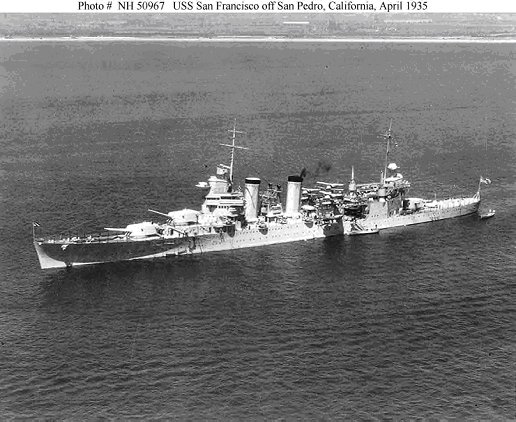
December 7, 1941 found the San Francisco tied up next to her sister New Orleans (CA-32) to a pier at the Pearl Harbor Navy Yard, her engines in pieces while she underwent a refit. Hastily put back together, she was back in service by mid-December. She spent the early part of the war as an escort first for Saratoga (CV-3) and then Lexington (CV-2). Assigned as a convoy escort, she missed participating in the Battle of the Coral Sea and the Battle of Midway.
On August 7, 1942, the American’s took their first steps on the long road to Tokyo with the invasion of Guadalcanal. San Francisco became part of the overall force covering the invasion.
In September, she was part of the screen for the carrier Wasp, when that ship was torpedoed and sank. Later that month, San Francisco became Admiral Norman Scott’s flagship with the formation of TF 64, consisting of the flagship and the cruisers Salt Lake City, Boise, Helena, Minneapolis and Chester, plus DesRon 12.
It was this basic force that intercepted a Japanese “Tokyo Express” reinforcement run on the night of October 11, 1942. In the ensuing Battle of Cape Esperance, the United States Navy achieved it’s first victory in a night action against the Imperial Navy, sinking the cruiser Furataka and a destroyer, in exchange for the loss of one destroyer, and damage to the Salt Lake City and Boise.
The next month saw the San Francisco, now flying the flag of her former commanding officer Admiral Daniel Callaghan, engaged in convoy escort work and shore bombardment duties.
On November 10, 1942, San Francisco and her covering force headed for Guadalcanal escorting a convoy of reinforcements, arriving off Lunga Point on the 12th. That afternoon, the convoy came under air assault. In the attack, a torpedo bomber crashed in the aft superstructure, wrecking the secondary command post and killing 15 men.
While the convoy was under attack, American air reconnaissance picked up a large Japanese force moving down the Slot towards Guadalcanal. The San Francisco and her consorts were ordered to intercept.
Heading up the through Ironbottom Sound in the company of the cruisers Portland, Atlanta, Juneau, Helena and eight accompanying destroyers, the force made radar contact with the Japanese around 130 on the morning of Friday, November 13, 1942.
The Japanese force consisted of two battleships – Hiei and Kirishima – a light cruiser and eleven destroyers. Due to weather concerns, Admiral Abe had reversed course back up the slot, and then turned back towards his target – Henderson Field. The course change had thrown his formation into disarray, with the two battlewagons practically in front of the destroyers that were supposed to be screening them.
Meanwhile, the Americans – misusing their radar once again – tried to cross the Japanese “T”. Instead, they steamed right down the middle of the bombardment force, so that there were Japanese ships on either side of the Americans.
At ranges of less than 1,000 yards, the two forces opened up on each other. American destroyers took on Japanese dreadnoughts at point blank range, while American ships fired on each other in the dark, unable to ask questions before shooting.
Into this maelstrom sailed the Callaghan’s flagship San Francisco, the sixth ship in the formation. At around 150, Callaghan gave his famous “odd ships fired to starboard, even ships fire to port”. The resulting battle was a vicious slugfest, likened by some to a bar fight in a darkened room.
Steaming down the line of Japanese ships, San Francisco had the misfortune to engage in a one on one duel with the Japanese battleship Hiei. At point blank range the 14” shells of Hiei devastated the San Francisco’s bridge, causing the ship to lose control.
Control was shifted to “Battle Two” in the aft superstructure, but another hit knocked this out, again causing the heavy cruiser to lose control. Finally the conning tower was able to establish control, losing it again due to a direct hit, then re-establish it once again, before the ship sailed out of the fight.
When the fighting broke off at around 230, Callaghan, as well as almost everyone else on San Francisco’s bridge, was dead, victims of a one on one fight with Hiei. On the Atlanta, Admiral Scott was also dead – victim of friendly fire from the San Francisco. San Francisco had absorbed 45 major hits. Over 100 sailors – including Admiral Callaghan and Captain Young – had been killed.
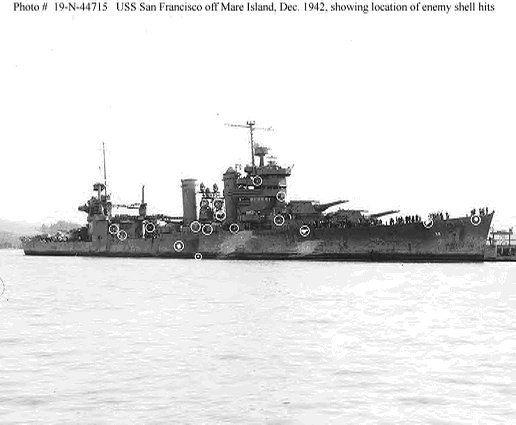
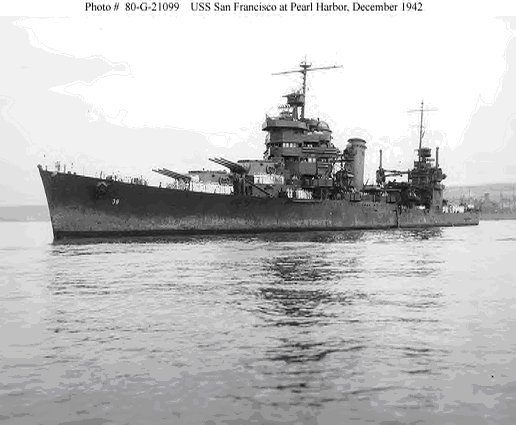
Atlanta was crippled, and would sink the next day. Portland had been torpedoed, and could steam only in a circle. Juneau was battered, and would succumb to a Japanese torpedo later that morning. Helena was relatively unharmed, but four of the destroyers had been sunk, and three others were a shambles. Of the tin cans, only the Fletcher came through without a stratch, earning her the nickname “Lucky 13”.
The Japanese had lost two destroyers, and the Hiei had been battered – her steering gear wrecked by San Francisco, who’s 8” guns were able to penetrate the Japanese armor at close range. Even though the American force had been battered – Henderson Field was not shelled. The Japanese had lost, and would feel the wrath of that loss the next day, when Navy and Marine aircraft administered the coup de grace on Hiei, which was vainly trying to escape up the Slot.
For her actions at Cape Esperance and at the Naval Battle of Guadalcanal, San Francisco was the recipient a Presidential Unit Citation. Four members of her crew, including Admiral Callaghan, won the Congressional Medal of Honor. Thirty One Navy Crosses and Twenty one Silver Stars were also awarded.
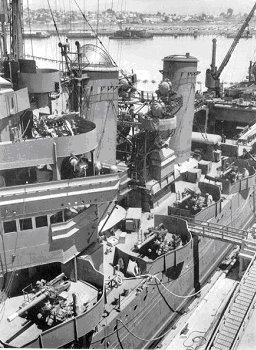
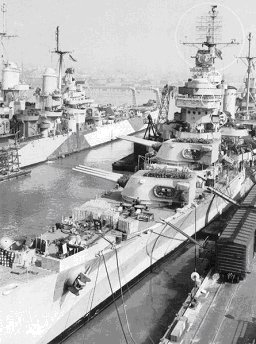
CA-38 returned to Pearl Harbor and finally back to the place she was born – Mare Island Navy Yard – for permanent repairs. She came out of her refit a much different looking ship. The damaged bridge was removed and replaced with a narrower, sleeker bridge. She went on to serve with great distinction for the rest of the war, earning a total of 17 battle stars. She was put into reserve in 1946, and scrapped in 1959.
It is part of the navigation bridge that makes up the memorial at Land’s End. The memorial is located just up from the Cliff House, a popular eatery right along the water. I unfortunately tried to get to it from the Legion of Honor (a museum and memorial to World War 1) which looked on the map to be closer to Land’s End than the Cliff House. That resulted in a mile or so hike on muddy trails along the coast. Luckily it was a picture perfect day in the Bay Area. The hike was a little tiring but the scenery was fantastic!
The memorial is right off a parking lot, and faces the sea, as if the pieces of the bridge were sailing back to the South Pacific to engage the Japanese one more time.
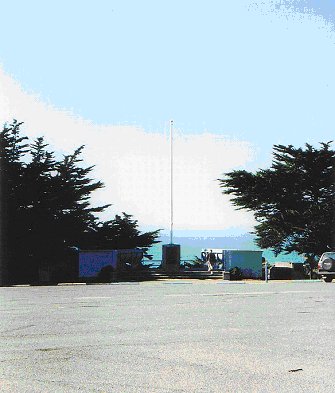
CA-38's Presidental Unit Citation
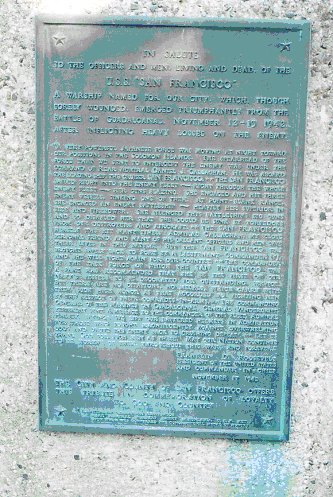
The USS San Francisco’s Presidential Unit Citation:
A very powerful Japanese force was moving at night toward our positions in the Solomon Islands. The spearhead of the force that we sent to intercept the enemy was under the command of Rear Admiral Daniel J. Callaghan. He was aboard the leading ship the cruiser San Francisco. The San Francisco sailed right into the enemy fleet – right through the whole enemy fleet – her guns blazing. She engaged and hit three enemy vessels, sinking one of them. At point-blank range she engaged an enemy battleship – heavily her superior in size and firepower. She silenced this battleship’s big guns and so disabled her that she could be sunk by torpedoes from our destroyers and aircraft. The San Francisco herself was hit many times. Admiral Callaghan, my close personal friend, and many of his gallant officers and men gave their lives in this battle. But the San Francisco was brought safely back to port by a Lieutenant Commander and she will fight again for our country. The commander of the task force of which the San Francisco was part of has recommended that she be the first of our Navy’s vessels to be decorated for outstanding service. But there are no citations, no medals, which carry with them such high honor as that accorded to fighting men by the respect of their comrades-in-arms. The commanding General of the Marines on Guadalcanal, General Vandergrift. Yesterday sent a message to the commander of this fleet, Admiral Halsey, saying: “We lift our battered helmets in admiration for those who fought magnificently against overwhelming odds and drove the enemy back to crushing defeat”. Let us thank God for such men as these. May our Nation continue to be worthy of them throughout this war, and forever.
Franklin D. Roosevelt
President of the United States
and Commander in Chief
November 17, 1942
Dedication Plaque
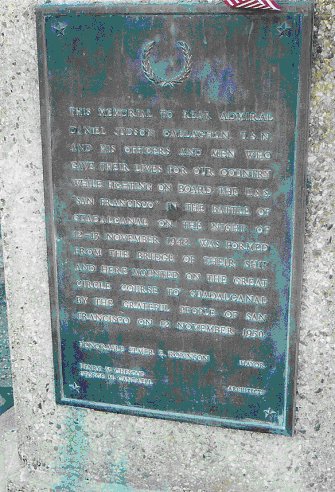
Navigation Bridge Wing
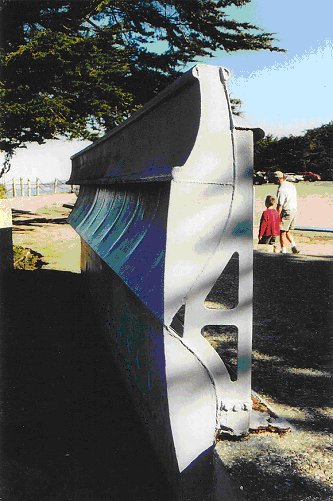
Note the shell holes in the bridge
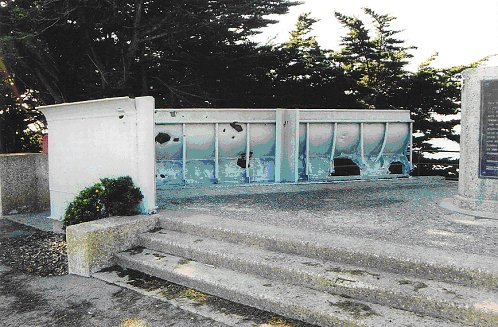
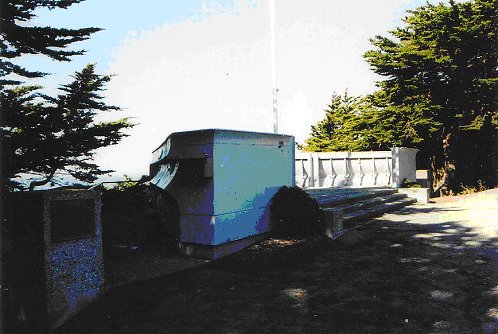
The Author at The Memorial
Related San Francisco Links on this site
USS San Francisco Photo Feature
Click Here for the Review of the Classic Warships 1/350 San Francisco kit.
Click here for the Review of the HP Models 1/700 San Francisco 1944 kit.
Click Here for the Review of the Naval Works 1/700 San Francisco 1942 kit.
Classic Warships New Orleans Class Photo Album
Class Warships San Francisco Warship Pictorial
Squadron US Heavy Cruisers in Action Part 1
